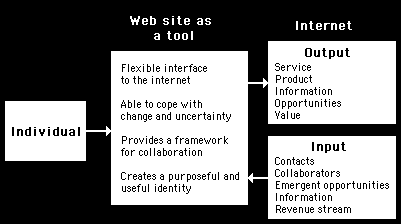
Chapter 5
More important than the business idea
Creating a source of wealth creation
The best way to make money is to find, or create, a non zero sum game: a wealth creating situation where all the players (collaborators) can gain by sharing the wealth created. Such situations invariably arise out of discovering new ways to improve efficiency. Here we have just such a situation.
A flexible Web presence can lead to improvements in efficiency because this is a way to cope with change and uncertainty. Adding to this advantage, a flexible Web presence can also provide a framework for collaboration that will facilitate a system capable of adaptation and evolution. Wouldn't this be beneficial to everyone involved?
Bill Gates' strategy had been to begin by constructing tools that would be useful to him and his collaborators. Couldn't a flexible Web presence be considered a tool? Couldn't a framework of collaboration also be considered a tool? Figure 5.1 illustrates how a Web site can be thought of as a tool by combining these features.

Figure 5.1
A Web site can be thought of as a tool that provides an efficient interface to the Internet
Returning to the green frog approach, I'd already determined that the first step beyond the green frog was to establish an identity on the Web. This I'd done by creating a domain name and IP address, but, a name and IP address isn't of any use unless it can be used for a purpose. I needed to give this identity a purpose. Once given a purpose, the Web site has to be provided with the ability to fulfill that purpose effectively.
The problem is that a Web site has the capability of being a highly complex identity. It isn't enough that it should act as a brochure or a catalogue. It isn't even enough that it should act as a retail outlet. A Web site needs to be an interactive part of a dynamic community – which is likely to be constantly changing and evolving.
This suggests that the Web identity should be such that it plugs into a dynamic system of communication and collaboration, which provides intelligence and direction. It should be designed to be adaptable and receptive to new and emergent opportunities. It is only by creating such complexity within a Web site identity that the full benefits of e-business can be realised.
This is an important initial need – common to anyone wanting to make strategic use of the Web for e-business – establishing a sophisticated identity on the Web that not only has purpose, but, will also optimise opportunities for collaboration and be able to continuously adapt to change.
Paradoxically, this initial starting place might be a good area to begin looking for an e-business opportunity. Everyone has to make a start somewhere and there are no obvious guidelines. By creating a suitable tool to deal with uncertain beginnings, you would be pioneering a pathway. Others might want to follow along this same pathway and be prepared to pay for the tools that have been created.
The first question that comes to mind is: what kind of identity to establish? The generic answer is that the identity should be such as to be able to take part in a profitable enterprise. The temptation then is to immediately leap forward into thinking about what kind of profitable enterprise that should be. However, this thinking would be pointless, if all you had was a domain name. How would people get to know about your enterprise? If the enterprise is based upon a good idea, how would you compete with others who might either copy that idea or improve upon it?
Rather than think about the idea and the enterprise, the first priority must be to give the Internet identity substance and power. Only then will it be sensible to think about the specific details of the enterprise because only then would you be in a more effective position to implement any business dealings or put ideas into effect.
To get this strategy into perspective, you might compare a Web site to a retail store. With this metaphor, it is easy to realise that a store (a Web site) is not going to be located in a busy high street when it is created. A Web site, on its own, is more like a store built in the middle of the Sahara desert. Clearly, whatever ideas you have for such a store are going to be totally useless until you get that store moved into an area where customers can know about it.
First thoughts might turn to advertising and marketing. The experiences of the early dotcoms are adequate proof that this is not a cost effective way to acquire a customer base. Besides being a very expensive way to attract customers, there is very little incentive for customers to stay loyal if they can find something more attractive just a mouse click away.
Certainly an expensive marketing campaign might attract customers, but, the cost has to be recouped. If the result is successful, it is only too easy for a competitor to look at what you are doing, make a few improvements and then offer the same service or product at a reduced price (or better service) because they haven't the liability incurred in the cost of the marketing. All too often, an e-business advertising and marketing campaign has attracted competition rather than customers.
Money and effort is better spent moving the store out of the desert and into a busy high street. In the world of the Internet this involves becoming a part of a network of communication and activity - in the parlance of the Web, this will mean creating or joining a portal or a vortal.